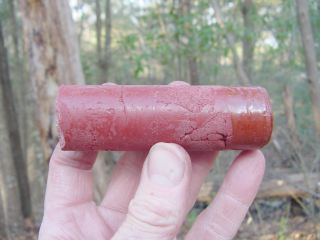
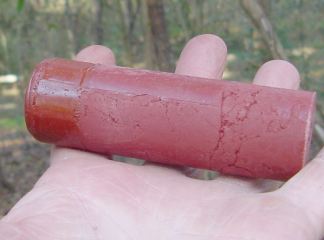
Having discovered that sodium nitrate
(a) does not work with recrystallization
(b) does work with the sugar syrup method
(c) burns more slowly, and seems to require a higher Kn ratio to achieve
steady state
I decided to make a larger grain to use in one of the Dr. Rocket aluminum casings and kick up the Kn ratio. I was unable to get a good burn in my model-rocket casings, and suspect that this propellant requires higher pressure than the paper cases can withstand. Today I plan to use a ~ 4-inch uninhibited grain in the 38-240 casing to get an initial Kn of 300 or a bit more.
The propellant:
200g sodium nitrate, oven-dried and ground to a powder a few days before
100g sucrose
30g Karo syrup
1 tablespoon water
As described in the syrup pages, the sugar, Karo and water were heated in one small saucepan while the sodium nitrate is warmed in another. When a drop of syrup spins a fine thread, it is ready and the oxidizer mixed in well.
The propellant is poured onto a glass pie plate and kept in a 200 degree oven until the grain mold is ready.
Slow oven-heating works very well with KNO3 propellant, whether recrystallized or made by the sugar syrup method. But this propellant behaved differently. It was a beautiful thick fluid at first, and could have been easily poured into grain molds. But after heating for a few minutes in the oven, it started becoming crusty on the top.
The temperature was raised a bit to 215 degrees. The propellant began to soften and liquefy on the bottom, but became even crustier on the top. As it was mixed with a spatula, the crusties became softer and more workable. But the longer it sat in the oven the worse it got. This is the opposite of KNO3 propellant, which remains viscous and even improves in texture upon long slow heating.
I tested a 1/4 inch diameter strand for 1atm burn rate and found it very slow, in fact not continuous. It would start burning and go out. I had to hold a torch flame on it to keep it burning. So 1% Fe2O3 was added. Now it burns continuously but slowly, about 22 seconds per linear inch at 1atmosphere.
So heated it up and crammed some of it into a mold. It was stiff. With considerable effort I managed to ram the core with a wooden dowel. A bit off-center at the head end, and crinkly in places. Here are some photos:


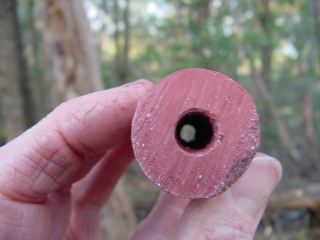
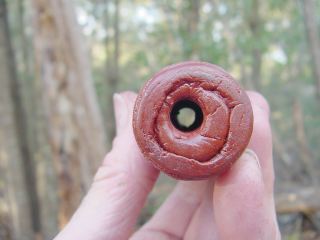
Note that the first inch or so of this uncircumcised grain.is a different color and texture. I had hedged my bets and put 15 grams of KNO3 rcandy at the head-end to help get ignition going. It should only have taken up the top 1/2 inch of the grain, but it was much softer than the NaNO3 propellant, and got pushed up around the outside. So much the better, this spreads it over more surface area to ignite. Note also that the core is a little off-center at the head end. Not good, but I did not want to have to mold this one again and will fire it as is. We will see the results of this error shortly.
The grain is placed in the 38-240 casing inside three layers of poster-board to serve as case liner.
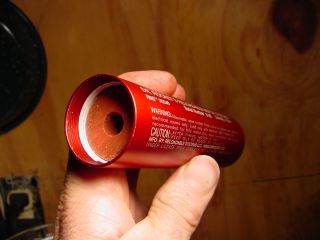
So here are the specs:
Uninhibited, hollow-core grain
Length: 3.86 inches
OD: 1.24 inches
Core: 0.37 inches
Weight: 120.9 grams
15 grams KNO3 recrystallized propellant, 10 seconds/inch
at 1atm
remainder is NaNO3 sugar syrup propellant, 22 seconds/inch
at 1atm
Nozzle throat: 0.294 inches (Aerotech phenolic, new)
Kn, Initial: 321 (not counting the irregular grain surface)
Kn, Final: 257 (not counting nozzle erosion)
Ignitor: electric bridge wire wrapped in masking tape with .3g homebrew black powder and a pinch of Mg turnings.
Unfortunately, the funky plywood test stand suffered death by PVC motor CATO back in December. I rebuilt it, but for much smaller motors, so we will have to settle for sight, sound, and smoke this time.
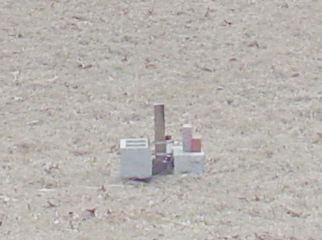
Click here for a video of this test.
(Beware, 1.2 meg download for 5 seconds of video)
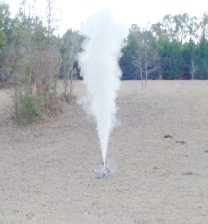
To my relief, there was a pretty good burn.
Here is what I got from the video/audio
| Time (seconds) | Event |
| 1.41 | Ignitor pops |
| 1.94 | Grain starts, moderate thrust |
| 2.44 | Full thrust |
| 3.39 | Thrust wanes |
Here is a capture of the wave file in GoldWave
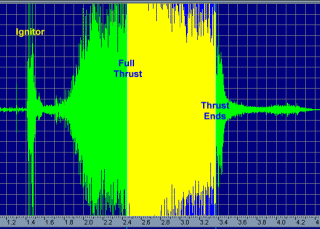
It doesn't show in this graphic, but there is a dramatic change in the
sound where the yellow starts and ends. I assume this to be the "steady
state" burn.
| Times (seconds) | Event |
| 0.53 | Ignition lag (to first thrust sound) |
| 1.03 | Ignition lag (to full thrust) |
| 0.95 | Full thrust duration |
There is a little "chuff" a the end of the burn, followed by a yellow star. I assume this to be from the sliver left by the off-center core at the head-end of the grain. And the nozzle had eroded to 0.32 inches by the end of the burn. So the final Kn would have been a little lower than anticipated, about 217.
The full-thrust part of this burn lasted almost a second. Similar grains in similar motors using KN/SU average about 0.6 second burn time. Following the conventional wisdom I read somewhere long ago: "The larger the motor, the slower the propellant" suggests that this propellant might scale up well. Particularly if it can be made to work with sorbitol, where the burn rate might be further reduced.
So.
It looks like NaNO3 can indeed be used as a rocket propellant oxidizer.
But why?
Well, it is cheaper than KNO3, but only by a little. And there
was the possibility that it would have a bright yellow exhaust flame, but
I did not see it in any of my motors. Apparently, NaNO3 has flame-suppressant
qualities much like KNO3.
The only substantial reason is that NaNO3 may offer a little better ISP than KNO3. I assume this is due to the sodium atom being a bit lighter than the potassium atom, thus less NaNO3 by weight is needed to oxidize a given amount of fuel. Whether this additional power will be realized, or if it will be worth the difficulties remains to be seen.
Further projects might involve:
1. Immediate molding of the propellant while it is in its liquidy state.
Unfortunately, this may eliminate one of my favorite features of recrystallized
KN/SU and sugar syrup KN/SU, the ability to reheat and remold it.
2. Larger motors, obviously.
3. Better ignition. Perhaps having the core of the grain
being faster-igniting/faster-burning KN/SU and the outer part of the grain
being this slower stuff.
4. A way to seal the grains against moisture. I wonder
if moisture within the propellant could cause problems over long storage
time.
5. Static testing on a calibrated test stand. I would like
to know if any of that additional ISP is being delivered yet!
Please send questions, comments, criticisms, and spare change to:
Jimmy Yawn
jyawn@sfcc.net
1/20/04